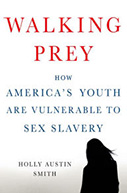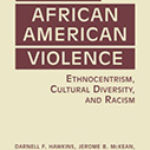Walking Prey: How America’s Youth are Vulnerable to Sex Slavery

Author: Holly Austin Smith
Publisher: New York: Palgrave Macmillan, 2014. 256p.
Reviewer: Annie Isabel Fukushima | September, 2016
Holly Austin Smith’s memoir takes the reader on an intimate journey through her experiences as a “willing victim” (or “willing participant”), starting at age 14, in a New Jersey sex ring. Smith’s book is part of an emerging genre of memoirs by survivors of human trafficking. But Walking Prey is a “hybrid memoir”: it is a survivor’s story intermingled with a “how to” guide for anti-trafficking professionals, including law enforcement officers, lawyers, social workers, mental health service providers, advocates and educators. It’s written in an accessible voice and it provides a great deal of descriptive detail.
Austin Smith intends for her memoir to be used in teaching and to make it accessible to a wide range of readers she utilizes many references to popular culture. Her other sources include governmental and non-governmental reports, news coverage, and her own psychiatric evaluations, as well as testimonials and memoirs written by other survivors of child sex trafficking. In addition, she discusses her own involvement in sex trafficking in Atlantic City, NJ, starting in 1992, at age 14. Her memoir is intended to stimulate productive dialogues among scholars and students interested in case studies, the narrative form, agency and choice, childhood studies, memory studies and mental health/psychology.
Austin Smith focuses the memoir on her role in navigating the complex line between being sex-trafficked and being a “willing victim.” She describes herself as predisposed to becoming a “willing victim”: whose risky behaviors were the product of her own history as a victim of child sex abuse and parental neglect. (The neglect was unintentional during her mother’s battle against cancer.) Austin Smith’s low self-esteem and her search for an idealized adulthood also made her vulnerable to abuse. After meeting her trafficker at a mall in South Jersey, Smith illustrates a particular dimension to child trafficking: it can be subtle; a part of the everyday; and it does not require violence. Smith’s trafficker, Greg represented a person who filled the void in her life, he even “looked cool” and promised a life where she could pursue her aspirations to be a songwriter.
Popular images of human trafficking as encompassing physical acts of force circulate in popular media; these images include a person chained, shackled or bound into their exploitation, physical beatings and abuse, and even kidnapping. Holly Smith’s narrative contrasts the common images of force often delineated in popular conceptions about human trafficking. A turning point occurred when she became involved with sex traffickers whom she calls Greg and Nicki. The author believed she had no options other than submission because her own predisposition to reckless sexual behaviors went hand-in-hand with her desire to belong to a welcoming group of people. Even describing her childhood self as believing that she was born to prostitute. In addition, Smith faults the systems of law enforcement and health care that relegated her to being seen as a “bad child,” even as she saw herself as caught up in a system of control and a rule-driven economy – sexual economies are driven by rules that govern the relationships between pimps and sex workers. The memoir form allows Austin Smith to examine the complex and uneven contradictory relationships each person has with choice. While Smith portrays a picture of a teenager who willing entered into sex work and its rules of engagement, she also illuminates the context of those choices. Her choices were limited by her vulnerabilities. It is through this narrative that Smith conveys how she, like many other young people are “walking prey.”
By dramatizing particular moments from recollections of her own intimate experiences during adolescence ̶ including her memories of explicit sexual experiences with different “Johns” ̵ Austin Smith compellingly invites the reader to vicariously experience the blur of her youthful sexual encounters.
Austin Smith’s retelling of events through adult memories makes this text particularly compelling for courses in memory studies and psychology. She walks the reader through specific events and contextualizes her own experience as shaped by her family, peer networks, media, law enforcement and health providers. However, unanswered questions include: how does trauma impact one’s ability to remember traumatic events? Traumatic memories can impact a person’s daily functioning, therefore, how does the memoir form also further a type of healing that does not force one to forget their traumatic memories, but rather contend with them? The roles of memory and mental health are deeply disentangled in the memoir. Smith calls for a mental health care approach to the problem: In her own healing she was diagnosed with Borderline Personality Disorder (BPD) and Post-traumatic Stress Disorder. Both BPD and PTSD are trauma and stressor related disorders. According to the American Psychiatric Association’s Diagnostic and Statistical Manual of Mental Disorders, Fifth Edition, individuals with Post-traumatic Stress Disorder may have difficult remembering events, recurrent, involuntary or intrusive distressing memories of the traumatic event(s). Her recollections of events raise fruitful questions regarding being able to remember that which one may desire to forget. It also points to how for some survivors of trauma, survivors like Smith, naming, or rather, diagnosing, their symptoms as related to their trauma, is helpful in understanding what is needed to heal. And how the memoir form itself can be a part of the healing as it enables survivors to contend with the events. One cannot move forward with treatment, or recovery and healing, if there is no clear diagnosis, which for Smith it was two personality disorder diagnoses. And while some survivors may desire to forget, it is clear in the case of Smith, that by documenting her story, she desires to remember the traumatic events.
Austin Smith concludes with practical recommendations. She advocates providing “intermediate and long-term care” to victims as the main solution to child sex trafficking. This approach would include: creating residential treatment options for some abuse victims and outreach services to others who do not need to live in a residential program; providing ongoing therapy and aftercare programs that provide exposure to other survivors and helping victims to develop an understanding of healthy relationships. She also advocates creating programs to provide victims with education and social awareness, community involvement, and life skills and job training.
Walking Prey grapples with the effects of poverty and criminalization on trafficked people’s experiences. The author’s message is “it can happen to all children.” However, human trafficking does not happen to all children. Therefore, important unanswered question include who is more likely to be visible as a trafficked child, and, in contrast, whose story and/or experience becomes categorized as criminal?
Walking Prey offers an important resource for thinking through issues involving child development, human trafficking, sexual economies, choice, memory and mental health. The book also offers unique resources, ̶ including handouts for classroom use and copies of Austin Smith’s psychiatric evaluations ̶ that should become useful teaching materials for educators and for legal aid and social service providers.
Annie Isabel Fukushima, Ph.D. is Assistant Professor, Ethnic Studies and the College of Social Work, University of Utah.


